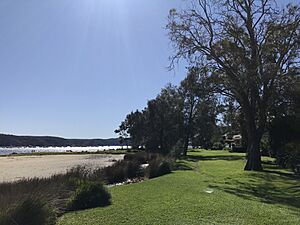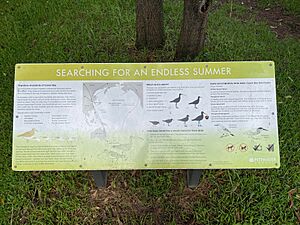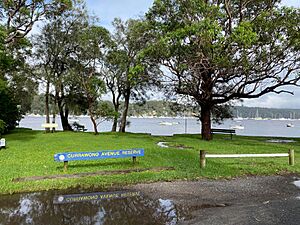Careel Bay facts for kids
Careel Bay is a beautiful bay and a small area next to it in Sydney, New South Wales, Australia. It's part of the Avalon Beach suburb. The bay sits near Avalon Beach and Palm Beach in the northeast part of Pittwater. It used to be called 'Evening Bay'.
Contents
Nature and Wildlife
Careel Bay is super important for nature! It has the biggest areas of mangroves and seagrass beds in all of Pittwater. These special plants are like underwater forests and nurseries for many fish. This makes the bay a vital place for young fish to grow before they head out to the bigger ocean.
Over 100 different kinds of birds have been seen at Careel Bay. Some of these are very special, like the endangered Bush Stone-Curlew. There's also the Mangrove Gerygone, which is important for the region. Many birds are international travelers! They fly all the way from East Asia to use Careel Bay as a resting and feeding spot. Countries like Australia, China, and Japan have agreements to protect these amazing birds and their homes.
Careel Bay is one of the most important wetland areas in the Northern Beaches of Sydney. It has a mix of natural features that are rare in Sydney, providing homes for many different sea creatures and birds.
Amazing Migratory Shorebirds
Imagine traveling over 24,000 kilometers every year! That's what migratory shorebirds do. They fly from Australia all the way to Siberia or Alaska and back again. They are truly global wanderers!
When it's winter in the northern parts of the world, these birds come to Australia. Our warm coastlines and estuaries (where rivers meet the sea) are perfect for them. Then, when it's our winter, they fly north to breed. They basically live in an "endless summer"!
Around September or October each year, these shorebirds arrive in Australia. Some visit Careel Bay, where the wide mudflats and rich marine life offer them excellent food and a safe place to rest.
Birds that visit Careel Bay include:
- Eastern Curlew
- Whimbrel
- Bar-tailed Godwit
- Common Greenshank
- Grey-tailed Tattler
- Red-necked Stint
- Ruddy Turnstone
- Pacific Golden Plover
In March and April, the birds get ready for their long journey back north. They eat a lot to build up fat, which gives them the energy they need for the flight. Many stop in the Yellow Sea (a four-day flight!) to refuel before flying another four days to their breeding grounds. Some even fly non-stop from Asia or Alaska to Australia – a journey of over 11,000 kilometers!
How to Spot Shorebirds
The best way to tell shorebirds apart is by looking at their bills (beaks). Their size can be tricky to judge when they're far away on the mudflats.
Some common birds you might see here are:
- Eastern Curlew
- Whimbrel
- Red-necked Stint
- Grey-tailed Tattler
- Pacific Golden Plover
- Bar-tailed Godwit
Help Protect These Birds
You can help keep Careel Bay a safe home for these amazing birds:
- Give them space: Don't get too close. Let them feed and rest without being disturbed.
- No dogs: Dogs are not allowed in these sensitive areas.
- Protect their food: Don't take or harm marine plants and animals in the area.
- Take your rubbish: Always take your trash with you. Plastic and fishing line can harm or even kill birds.
- Bring binoculars: Get a closer look and learn about these incredible creatures!
Your care helps make sure future generations can also enjoy seeing these wonderful birds.
Local Birds of Careel Bay
Some birds live in Careel Bay all year round:
- White-faced Heron: A common bird often seen feeding along the shorelines.
- Mangrove Heron: This bird is very good at hiding. It slowly sneaks up on its prey before quickly lunging with its long neck.
- Royal Spoonbill: A large white bird with a unique spoon-shaped bill. Spoonbills swing their bills side to side in shallow water to find food.
- Mangrove Gerygone: Careel Bay is the most southerly place you'll find this tiny bird. Listen for its beautiful warbling song from the mangroves!
Landmarks
- Careel Creek: This small waterway is about 1 kilometer long. It flows into Careel Bay, bringing fresh water from nearby areas.
- Careel Head: A headland (a piece of land sticking out into the sea) on the coast.
- Careel Headland Reserve: A natural reserve along the shore, great for exploring.
Sports and Fun
Careel Bay offers lots of ways to stay active and have fun!
- Careel Bay Tennis Club: This club has five great tennis courts with lights, a clubhouse, and a shop. They offer tennis lessons for all ages, even starting from two years old!
- School Holiday Camps: During school holidays, kids aged 4 to 16 can join camps here. They offer tennis, soccer, cricket, basketball, and more. You can choose full-day or half-day options, and there's even free before and after camp care for parents.
- Careel Bay Playing Fields: These fields are used for sports like cricket, baseball, and little athletics.
- Careel Bay Boat Ramp: A concrete ramp where you can launch small boats.
- Careel Bay Ecosystem Field Trip: A great way to learn about the bay's environment.
Parks
- Careel Bay Bushland Reserve: This reserve is very important for nature. It has mangroves, saltmarsh, seagrass, and mudflats, which are home to many different plants and animals, including the migratory shorebirds. To protect the wildlife, dogs and cats are not allowed here.
- Careel Bay Crescent Reserve
- Currawong Avenue Reserve
Wharf and Boats
- Careel Bay Wharf: This wharf is used by commuters and for commercial purposes. It's the main spot for dropping off heavy materials for the western foreshore areas. There's also a marina next to the wharf.
- Careel Bay Dinghy Storage: If you have a small boat (dinghy), you can store it here on the grassed areas. There are 53 spots available, and it also has access to the boat ramp.
Getting There
You can get to Careel Bay by bus or car using Barrenjoey Road. Bus route 199 can take you to Manly wharf. <mapframe latitude="-33.611045" longitude="151.319332" zoom="13" width="283" height="283" align="right" />




